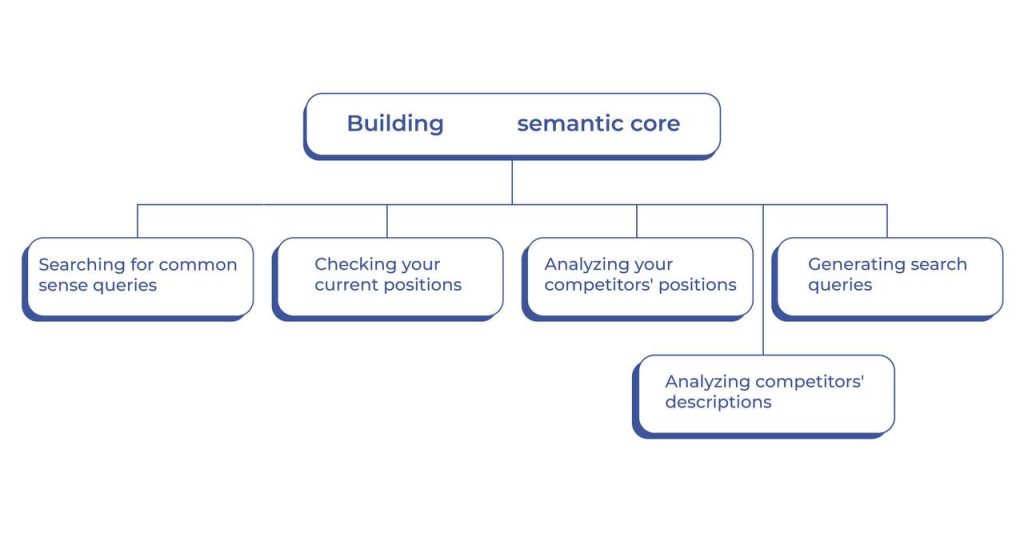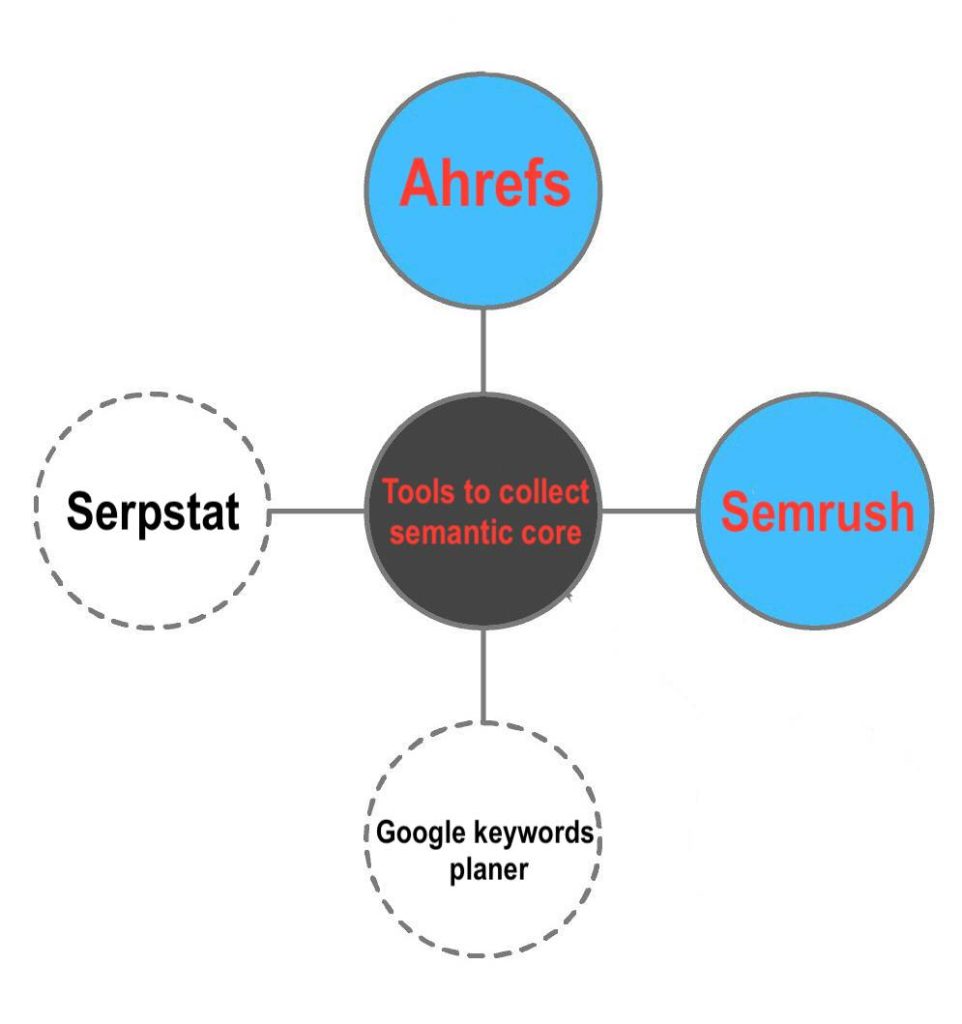What is the semantic CORE
What is the semantic core?
Your company’s website represents your business in a plain and straightforward way. We are aware that layout and design are crucial to the user experience, but equally so important are the contents that compose the majority of the website. The most effective websites use something called a semantic base, which can be loosely defined as a collection of phrases and words that users browse and arrive at your site from search engines. The words and phrases you choose to use should be applied throughout your site to ensure that they are “picked up” by search engines when people search for them.
Quick Links
Keywords are classified by their popularity into three categories: medium, high and low frequencies. For example, the term ” Physics” is in the very high-frequency (HF), “Physics university” will be the mid-range frequency, while “Physics university in Montgomery County” is in the lowest frequency (LF). As you might guess, the more well-known an expression or word is, the greater competition you will face when trying to make it an indication of your business (this is because many others are using the same idea). Also, the more popular a keyword or phrase is, the better the outcomes you will get when it is used to represent your site’s semantic basis. To be at the top of Google’s ranking for competitive words and phrases is a difficult task. However, it can produce incredible outcomes.
How to Find Keywords for your website
It can be done manually or in an automated way. These include specialized keyword research services. We’ll talk about these services later.
Keywords during research are chosen and collected by analyzing the services and products of your site along with the competitors in terms of key phrases. the most focus is concentrated on the statistics of keywords: including search volume, seasonality, and more.
The primary goal is to create a website for all search queries that can meet the requirements of the audience.
The entire process involves:
- Collection of keywords that describe the site’s contents in depth, considering its topic and the purpose of the website;
- A clustering of keywords that are related to the meaning of each into subsections and sections.
- The optimization of every website page for keywords that are collected in groups.
In the course of keyword research for any site, Search queries must be classified into commercial and noncommercial queries.
Commercial queries encompass all the keywords that people use to search to buy. They usually include terms such as “buy”, “purchase”, “price”, “cost”,etc.
Non-commercial searches are often used to find non-commercial information.
Another crucial criteria is the number of keywords searched.
A high volume of searches means that a specific key phrase is searched for the most often. These keywords are likely to accurately define the field and are utilized by your primary competitors frequently. Thus, putting them in the top position of the results page is the most difficult. Keywords that have little search volume are utilized less frequently than other.They are usually long-tail keywords that are composed of multiple terms. The main benefit is less competition to rank at the top of SERPs. Additionally, they tend to be highly particular and draw a targeted audience who knows exactly what they want.

How to Compose a Semantic Core Consistently
Once the semantics core is assembled, it is possible to move to the next step which is spreading the semantics across pages. This should be done in a way that the most important queries within different sections don’t intersect each other.
The SEO optimization technique is distinctive for every internet resource and developed by the tasks that are assigned. Traffic can be generated in ways that are directed only to the main site or to a particular section, or even to specific landing pages within specific sections. A clear action plan significantly simplifies SEO-optimizers’ jobs and for the user. It will result a substantial reduction in the cost and an acceleration of the working speed.
The next step is an in-depth analysis of each page of the site, and the compilation of pertinent Titles as well as Description of Meta tags along with H1-level headings. For online stores, and also for information resources and sites that offer services, it is essential to gather the most comprehensive semantic core that doesn’t comprise “garbage” and unnecessary requests which do not attract visitors. In real life, the design of the web page will look like this:
- Analysis of every request of the group and their division into low- and high-frequency ones;
- Analyzing the content of the competitor’s site for every request, and determination of the importance of keywords;
- Creating the most effective Title, Description, and H1 headings;
Then on to the next section as well as for each landing page.
Tools to build a Semantic Core
There are numerous services to create a semantic core online. Some are priced at a premium, others provide an opportunity to test the software for free for a couple of days, and others are completely free. We prefer to utilize variety of tools, which differ by kind to get the best outcome for websites.
In most cases, different techniques let you increase the value of a current list of keywords. We recommend using Google Keyword Planner and the leading SEO services like Ahrefs and Semrush. Include them in your tools for researching keywords. Each one of them uses semi-automatic methods to create semantic cores. In recent times, Google has been effective in helping to build an organic semantic core giving users terms related to their search. This is a method that many have previously used.

Mistakes that people make in the construction of the semantic basis
There are a few common errors that novice optimizers make while collecting semantics.
* When you take data from a single source. When semantics are taken from a single source you drop many queries that can aid in helping to promote the site. We suggest the following list of keywords services for choice: Serpstat, keyword scheduler Google Ads, Semrush, and Ahrefs.
* Skip synonyms. The semantic core that is not enriched by synonyms is incomplete. When collecting semantics, it’s essential to include synonyms in the core. This can increase the relevance. For instance, the repair of phones is the same as the maintenance of phones and so on.
* Incorrectly clustered queries. If you have incorrect clustering, the relevance of the site’s pages decreases drastically, which harms the effectiveness of the promotion. When you are clustering queries, you must know the people put in the query and how to disperse the queries across the site’s pages.
Author: Rachel R. Hill

An ambitious researcher and talented writer, Rachel found an immense amount of joy in sharing her skills and knowledge with others. Her job as a departmental assistant allows her to stay in touch with students, always ready to lend a hand or give an ear. Now Rachel is one of the writers on internet platform study crumb, willing to branch out and give advice to a much bigger audience online.
What Is WooCommerce Product Slider and Why Your Store Needs It
Why Do Product Images Matter So Much in Online Stores? When someone visits an online store the…
0 Comments9 Minutes
How to Streamline Your Customers’ Shopping Experience?
The goal for any online store is to make shopping as smooth as possible. When visitors move…
0 Comments8 Minutes
Strengthening Brand-Customer Relationships Through Gamified Loyalty Programs
Creating lasting connections with customers has become increasingly vital as the marketplace grows…
0 Comments6 Minutes
How to Use SEO and SEA Together in Search Engine Marketing
In digital marketing, search engine marketing (SEM) plays a critical role in improving online…
0 Comments10 Minutes
Content Marketing Growth Hacks: Real Shortcuts to Drive Traffic
Are you still lagging in content marketing? Sticking to these old strategies seems…
0 Comments10 Minutes
How to Build a Strong Local Following Using Social Media Marketing
In the days of likes, shares, and stories, local businesses have a golden opportunity to create…
0 Comments9 Minutes
Why WooCommerce is the Best Choice for Your Online Store?
WooCommerce stands out as a top option for anyone looking to build an online store. This platform…
0 Comments8 Minutes
How to Use AI-Powered SEO Tools for WordPress eCommerce
SEO is a critical factor in the success of any e-commerce WordPress store. As competition…
0 Comments11 Minutes








